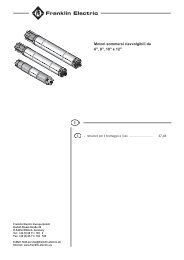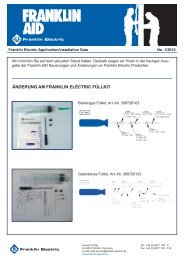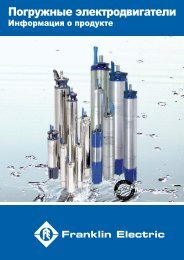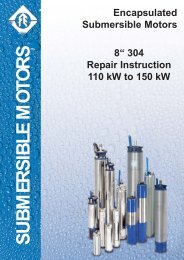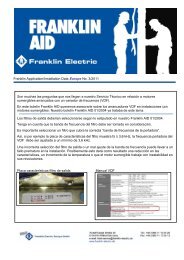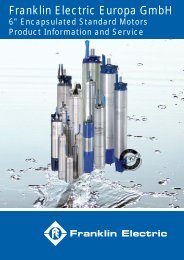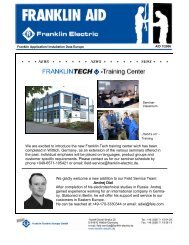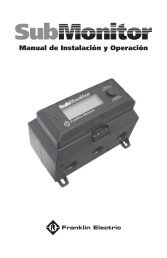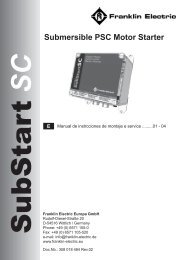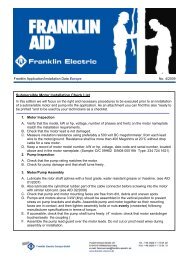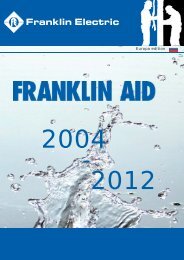AID - Franklin Electric Europa
AID - Franklin Electric Europa
AID - Franklin Electric Europa
You also want an ePaper? Increase the reach of your titles
YUMPU automatically turns print PDFs into web optimized ePapers that Google loves.
<strong>Franklin</strong> Application/ Installation Data (<strong>AID</strong>) Europe 1/2007Fight against SPLINE WEARIn this <strong>Franklin</strong> <strong>AID</strong> we would like to point out some facts about couplings and splines.RECOMMENDATIONS:1. Coupling:- Coupling material (powdered metal parts) needs to be compressed as high aspossible (of high density).- Assure coupling splines are dimensionally correct to provide uniform toothloading.- Assure quality of coupling material is matching material of the shafts (in orderto avoid galvanic currents).- Couplings featuring a hardened washer between pump and motor shaft ends arethe preferred option (avoids chips in the spline area).2. Lubrication: The spline compartment of rotor and coupling must be filled properlywith a water proof silicon grease, or if not available: Vaseline, to be found in anypharmacy.3. Loose fitting coupling (coupling shall be tied fixed on pump shaft, but free on rotor splines).4. Sealing: Make sure coupling is designed to touch the rotating sandslinger, in order to avoid entry of abrasiveparticles into the spline area.5. Misalignment: When mounting pump to motor, it should be checked, if motor and pump are properly in oneline.- Wet ends with plastic or very lean investment casting/sheet metal inlets are likely to cause misalignment.6. Centering: Motor to pump must center properly each other to avoid any side–load.7. Respect maximum recommended torques of the pump manufacturer when attaching the pump to the motor.8. Handle long units (higher head pumps already attached to motors) with care to avoid permanent deformation.Reduced spline lifetime due to:· Upthrusting conditions, i.e. pump operation at the very right hand side of the pump curve (large quantity, smalltotal head).· Water hammering, high dynamic conditions in the pipe system.· Frequent switching (on and off), such as with broken bladder in the pressure vessel.Recommendation: Max. 20 per hour.- Chattering relay contacts.· Overpumping, possibly due to wrong pump selection, creating sudden changes in torque (pump discharge largerthan well water supply).· Motor back spin, resulting in increased shock loading on motor start-up (faulty pressure system, leaking checkvalve).· Excessive or insufficient revolutions (as a result of backspinning due to a leaking or missing check valve).· Pump cavitation will shock load the splines and/or induce vibrations which may cause stripped spline oraccelerated spline/coupling wear (right selection of pump in accordance to suction conditions – NPSH).




